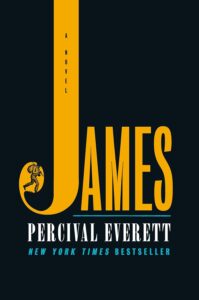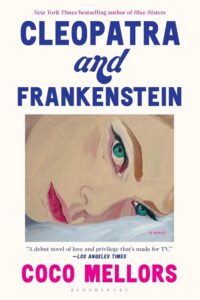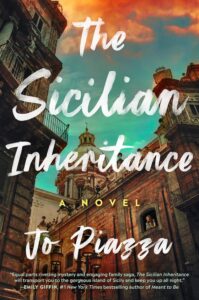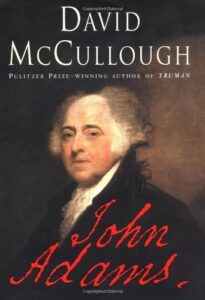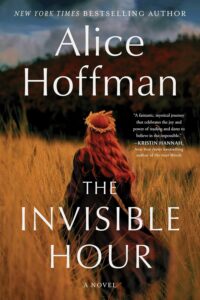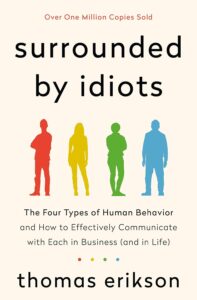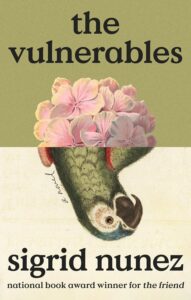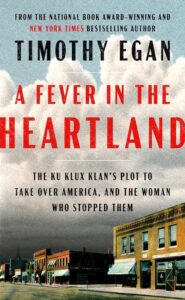James
Percival Everrett
Knopf Doubleday Publishing Group, March 19,2024
James, written by Percival Everett. is a thought provoking and reimagined version of Mark Twain’s classic, The Adventure of Huckleberry Finn. This gripping novel is the brutal retelling of Jim’s marginalized voice in an unforgiving way. James is told from the perspective of the enslaved Jim, who in Twain’s version is the comic side-kick of Huck. This novel is not a children’s adventure story but a story based on an historical viewpoint of the pre-civil war time period.
Early in the novel the reader is made aware of James’s intellect and cunning survival skills. His ability to have mastered the art of “behaving” and using his “slave filter” to make himself sound incredibly uninformed to white tormentors is exemplified when James is teaching his technique to a group of enslaved children. He has taught these children to understand that, “ the better they feel (white people),the safer we are”. James then asks them to translate that belief using slave talk, “da mo’better day feels, da mo’ safer we be” is their collective response.
James is a veracious reader who often has imagined conversations with philosophers like Rousseau, Voltaire, and Locke about slavery. But being literate presents James with the question, “what would happen if it was realized that a slave knew what a hypotenuse was, or what irony means, or how retribution was spelled?”
As the story progresses, the reader does sense that James parallels the basic outline of Twain’s story. However similar this novel and the 1884 version may appear, James’s adventures with Huck or travels on the Mississippi could not be more different than the original. Everrett’s novel is fast- paced just like each of the adventures that James and Huck encounter.
Although hard to imagine what it might require for a runaway slave to stay alive, James describes one unforgettable adventure when forced to join a roving mistral band.
Never had situation felt so absurd, surreal and ridiculous. And I had spent my life as a slave. There we were, twelve of us marching down main street that separated the free side of town from the slave side, ten white men in blackface, one black man passing for white and a painted black, and me, a light-brown black man in such a way as to appear like a white man trying to pass for black.
I most highly recommend this 2024 winner of the National Book Award for Fiction . This was one of my all time favorite work of literary fiction. Be prepared to go emotional roller coaster ride but trust this reader, Percival Everrett’s James, is worth the risk!
Cleopatra and Frankenstein
Coco Mellors
Bloomsbury Publishing, January 30, 2024
I’d been on the waitlist for a month or so when this became available, and I thought, how timely since I would be writing this around Halloween. But until I read it I would have no idea how well the title would relate to the characters. (She was a great beauty and he could be a monster–but actually, they were Halloween costumes.)
Cleo, a painter, and Frank, an advertising executive, meet in an elevator as both are leaving a New Year’s Eve party–she to go home, since she is broke, and he to get some more ice. He winds up walking her all over New York City and they somehow know they are meant to be together, especially since her green card is expiring. They quickly marry and then the trouble begins because they hardly know each other.
The author brings the reader along to show how both Cleo and Frank’s families and close friends have contributed to the awful childhoods and the adult lives’ house of cards. The most honest voice is a copywriter Frank was forced to hire; she may also have been the funniest voice.
By the end of the novel, the reader sees hope for Cleo and Frank, and no hard feelings. So not a happy ending, but a real one.
The Sicilian Inheritance: A Novel
Jo Piazza
Fiction Dutton Publishing, April 2, 2024
Sara finds herself with a plane ticket in hand to Sicily after the death of favorite Aunt Rosie. She’s just suffered the loss of a business and a husband so is quite ready to find out if she is entitled to the deed of a possibly valuable piece of land the matriarch left her. Just a few days…turns into a murder mystery. She tells her story and is tangled into the same web her Great Grandmother found herself in the early 1900’s.
One chapter is about Sara “today” and another about Serafine “then.” It was historically interesting to learn that many Sicilian men left for America in the 1930’s to earn money, leaving the women and children behind to come later. But Serafina did not come later.
Turn to this twisting adventure to find the real truth!
John Adams
David McCullough
Biography
Simon & Schuster, 2008
Introduction
This book is a biography of John Adams, one of the Founders of the United States of America, and the fourth President of the United States.
Author
David McCullough is a multi-award-winning author in several genres. He won the Pulitzer Prize for this biography and his biography Truman about President Harry Truman. He has twice been awarded the National Book Award. He has also been awarded the Presidential Medal of Freedom.
Story
This book is a tremendous review of American history as we approach the 250th anniversary of the country’s founding in 1776. I love history to begin with, but lately have felt like I needed a good refresher on American history. I’ve read several of David McCullough’s books and have loved them. I was recently at the Museum of the American Revolution and was in the shop at the museum and saw this book sitting on one of the books shelves. I didn’t buy it. I chose to check it out of the library when I came home.
The book takes us from John Adam’s early life in Braintree, Massachusetts, his time at Harvard University, and his early career as a lawyer in Boston. We learn of his early love of books and reading which stayed with him his whole life. We start getting into American History when the Boston Massacre happens in March 1770 when a squad of British soldiers fired into a crowd of several hundred colonial Americans who were demonstrating on the streets of Boston. The Massachusetts authorities put the soldiers on trial, but no one was willing to defend them—until John Adams stepped forward. A great believer that all persons deserved defense when charged with a crime, he agreed to defend all nine of the soldiers. And they were acquitted! He won his case!
John Adams became involved in the early discussions about the difficult circumstances the American colonies were experiencing under King George III of Great Britain. As circumstances deteriorated and the great minds of the colonies began to search for how to resist the unfair taxes and oppression of Great Britain, John found himself involved in these conversations. When the colonies decided to create a Congress of the colonies to decide collectively how to respond to King George III, John found himself selected by the Massachusetts colony legislature to be one of their representatives at the Congress.
The book takes us through the discussions that led to the decision to write the Declaration of Independence. We learn of John Adams earliest thinking and writing on the concept of a form of government which featured three separate branches of government with checks and balances to ensure one branch did not overpower the other branches. We are taken through the American Revolution and John Adams role as a diplomat to France, Holland, and ultimately the first U.S.Ambassador to Great Britain. Ultimately, we watch as the Americans win their independence from Great Britain and John Adams becomes the first American Vice President. After George Washington’s two terms as President, John Adams becomes the second U.S. President.
Throughout the book, we are made privy to the great love affair John had with his wife Abigail, and the importance to both of them of family and family relationships. During their lifetimes, the Adams experienced many heartbreaks. But they also saw their oldest son John Quincy grow to become an important diplomat in the U.S foreign service. Ultimately, John Adams got to see his son become the sixth President of the United States.
The book is full of American history and important people from our country’s history. It was refreshing to have all of that brought back to my memory and placed in the context of John Adams’ life. Of particular interest to me was the friendship between John Adams and Thomas Jefferson. While there was a 20 year or so period in which Adams and Jefferson were on different sides of the political fence, in the end the friendship carried through in their relationship and they remained friends right up until they both died on the same day, July 4, 1826, the fiftieth anniversary of the signing of the Declaration of Independence.
Evaluation
The book is American history written largely in the context of the life of John Adams. I learned much about Adams I had not been familiar with, or at least had not remembered from my history lessons. I was quite taken back by how important writing was to John Adams. He kept diaries, he wrote down his thoughts about life in the form of pamphlets or little books, and he wrote and he wrote and he wrote letters. To everyone! And he loved receiving letters. At the end of this book, David McCullough says he discovered that over their lives, John and Abigail wrote over a thousand letters to themselves! In many ways, I object to the ways in which computers and the internet have changed our traditions of writing letters. While theoretically what we say via email and Facebook and Instagram are capturable for posterity, I don’t believe it carries the same quality of expression that letter writing did in its day. I was amazed at the number of people John Adams kept up with over his 90 years of life through his letter writing.
If you love history, this book is full of it. If you love people, this book if full of them. If you like politics, this book is full of it. I highly recommend this book as preparation for our 250th birthday of a nation in two years.
Eastbound
Maylis De Kerangal
Translated by Jessica Moore
Archipelago Publishing
February 7, 2023
These guys come from Moscow and don’t know where they’re going. There’s a crowd of them, more than a hundred… their arms veiny and eyes pacing the train car…. guys lining the walls in passageways and corridors, sitting, standing, stretched out on the berths, letting their arms dangle, their feet dangle, letting their bored resignation dangle in the void. They’ve been on board for more than forty hours now, crammed together, squeezed into the liminal space of the train: the conscripts.
Aliocha is a twenty-year-old conscript, who hoped he would manage to avoid military service as all young single men in Moscow attempt to do. Without the necessary means that might erase the threat of service, they try for reprieves, false medical certificates, bribery, and finally try to find a woman, because at six months a pregnancy will grant an exemption.
But Aliocha is now one of a hundred on this train. As the train rushes towards the unknowable destination, the idea of escaping suddenly floods his very being. Run away, get out, defect, jump.
Eastbound takes place almost entirely on the Trans-Siberian train, the longest single rail line in the world, between Moscow and Vladivostok, a quarter of the circumference of the world. At the next stop, Aliocha steps off with the idea of desertion, but is brought up short by his own fears. “Who does he think he is? Before he runs, he still has to get past his filthy ignorance and know where he’s putting his feet.” He is the last to climb back into the train car.
Into his compartment comes a woman, older than he, a foreigner. Without shared language they introduce themselves. She is Hélène, and she is also fleeing east-- from a love affair and an existential crisis. Aliocha manages to ask, in pantomime, for her help to hide him.
The story of two unlikely people in their quest for freedom is set against the background of the brutal landscape of Siberia. It is the exquisite writing, the language in this book, that not only kept me completely enthralled but sent me back to reread it a second time.
The first corridor is empty, everyone’s fast asleep—it’s outside that things are happening, the dawn raising up the forest at full tilt, lifting each trunk to vertical, the bluish underbrush perforated by rays charged with a carnal light, the taiga like a magnetic cloth, modulated to infinity by the new thickness of the air.
Languid when describing the nearly unchanging scenery, inside the train De Karangal’s sentences then race along, duplicating the movement of the Trans-Siberian, tumbling over each other as the tensions mount.
Train car follows train car, the same doors with warm sticky handles, the heavy panels sheathed in black rubber that must be unstuck one from the other spreading elbows out to horizontal, the same accordion-pleated vestibules that shake, where the temperature drops, where the ground whips past through gaps in the metallic floor—wood ties, gravel, patches of grass—the deserted corridors like gaping holes that snatch at them and they throw themselves in headfirst eyes riveted to the ground, they must not stop, they must do it fast and then they’re at Hélène‘s compartment.
The tension builds towards confrontation as the military guards search for their deserter and the violence we sensed in the young conscript emerges again with his fear and desperation.
A country I will probably never visit becomes real in Eastbound, and as grim as it sometimes sounds, made me want to see it, want to be there myself, (want to experience the sight of Lake Baikal as the Russians do, with cheers, and tears, and glasses of vodka).
I loved this book. It is short and perfect and just enough.
The Gardening Book
Monty Don
Clarkson/Potter Publishers
New York April 2024
Calling all gardeners. Read this book, it’s a game changer!
Monty Don’s newest book outlines how one begins a garden, enhances an existing garden, and learns to enjoy the triumphs of one’s efforts.
This how-do book has beautiful photographs and detailed explanations and information on every aspect of gardening. Starting with making a plan, to creating a soil chart, to encouraging wildlife visits, there is literally “no stone unturned” when it comes to the garden. The Gardening Book provides gardeners the ground work for growing flowers, vegetables, shrubs and uses the guiding principles of “the right plant for the right place” - a fail proof (mostly) approach to planning one’s gardening decisions .
As an intermediate level gardener I thought Don’s emphasis on soil preparation and the influence of the inextricable relationship with the soil structure and the nutrients needed for hearty and healthy plants was a lesson well learned as to why some plants (and I) have struggled/failed in my garden.
Monty rather decisively informs the reader:
No element in your garden is as important or influential as soil.
It is earth and the goddess Gaia, and she shall not be mocked.
For this reader this advice might be the single most important take away of the book. After reading The Gardening Book, I now carefully consider my soil and how best to efficaciously sustain my plants.
Don also gives us “permission” to dig up established plants for the sake of improving a garden’s appearance and success, as well as providing us with basic tenets for lush results.
“Make borders wide, and paths narrow” , “create focal points”, “accept that simplicity nearly always looks best”, and consider “ designing rooms in the garden with both living and constructed elements”. As a result, this gardening family has The Shade Garden, The Patio Borders, The Fern Garden, The Welcome Garden, The Stream Bed, The Meadow, and The Vegetable Garden. All seven “rooms” are within one-third of an acre.
Monty Don is an inspiring writer as well as a renowned Gardener and a BBC broadcaster. His sensible and thoughtful approach (he empathizes when plantings fail) to designing and transforming your garden is exciting, simply, for this reviewer, because with his guidance my garden is thriving!
The Gardening Book by Monty Don is a must read for anyone interested in plantings of any kind. I highly recommend adding this book to your library.
Note: Monty Don’s, Gardeners World, a BBC TV series is available on several streaming services. If you choose to watch this program, I promise you won’t be disappointed .
The Invisible Hour
Alice Hoffman
Atria Books
August 15, 2023
It’s always a delight when there is a new book from Alice Hoffman. Her brand of magical realism has entertained this reader for more than three decades. Although the hook of this novel is not the Owens family, which she’s written about in a handful of books, the story involves fellow New Englander Nathaniel Hawthorne and The Scarlet Letter.
The main character, Mia, is a teen living with her mother in a cultish group that shuns all outsiders. After something terrible occurs, she runs away and ends up at the library, finding a copy of The Scarlet Letter seemingly inscribed to her. She doesn’t understand how the author seems to have known her history, but she travels through time for real and not just by imagination to answer all her questions and take control of her story.
Hoffman’s lush prose is mesmerizing; I had trouble putting the book down. I most enthusiastically recommend it!
Sonja’s Pick
May 2024
The Accidental Empress
Allison Pataki
Howard Books, October 13, 2015
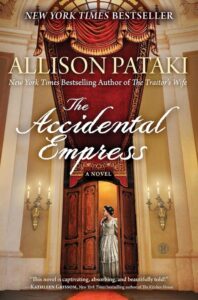 It is 1853. The Hapsburgs are Europe's most powerful ruling family and their 23-year-old Emperor is looking to marry. His mother sets up a meeting with her niece Helene who travels to see him with her sister, 15-year-old Elisabeth, and their mother. Franz Josef is smitten with Elisabeth and not Helene and she with him. The next year they marry.
It is 1853. The Hapsburgs are Europe's most powerful ruling family and their 23-year-old Emperor is looking to marry. His mother sets up a meeting with her niece Helene who travels to see him with her sister, 15-year-old Elisabeth, and their mother. Franz Josef is smitten with Elisabeth and not Helene and she with him. The next year they marry.
Elisabeth is completely unprepared for the life she must ease into. Franz Josef is too busy to see her and after producing two children she is not even allowed to be with them. She is distraught. We are brought into her bedroom and into state rooms feeling their closeness yet estrangement. We want her to stand up to them all, but alas it is the 19th century.
Sisi, as she is fondly called, becomes the most beloved of all Hapsburg Queens. They reside briefly in many of their castles but she falls in love with Hungary, especially Budapest, staying there as much as she can.
Elisabeth is absolutely beautiful with hair down to the floor; hair which the maids spend hours enhancing. Love affairs trickle through the story. It’s an exciting read with a tinge of politics thrown in too. She’s a spirited young thing and we watch her mature and find her place.
Pete’s Pick
April 2024
The Librarian of Burned Books: A Novel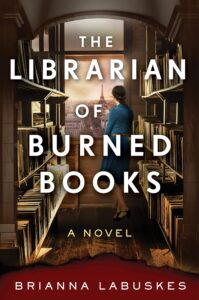
Brianna Labuskes
Historical Fiction
William Morrow Publishing, February 21, 2023
Introduction
This novel is about the role that books have played in politics, particularly world politics, as well as the incredible historical significance that efforts to ban books from libraries and bookstores has played in world history and is now playing out in our own history here in the United States of America in the 21st century.
Author
Brianna Labuskes is a Wall Street Journal, Washington Post, and Amazon Charts bestselling author of psychological thrillers and historical fiction. She was born in Harrisburg, PA, grew up in Pennsylvania, and graduated from Penn State Unversity with a degree in journalism. For several years, she was a journalist for national new organizations covering politics and policy. She lived in Washington, DC for many years and now calls Asheville, NC home.
Story
This story opens in late 1943 with one of the main characters, Vivian Childs, receiving a telegram that her husband had been killed in action during World War II. It immediately moves to a scene in May 1944 where Viv is crashing a luncheon in NYC being hosted by Senator Robert Taft of Ohio. Viv is working for the Council on Books in Wartime, which distributed paperback books to American servicemen through a program called American Service Editions. The were deliberately designed to be a size that fit into the breast pockets of the uniforms worn by American servicemen and were intended to give them something to read in their downtime from whatever their wartime mission was. Senator Taft had drafted an amendment to the Soldiers Voting Act of 1944 which had been passed by Congress and which would ban about 90 percent of the books the Council on Books in Wartime wanted to send out as ASEs. This included books like The Adventures of Huckleberry Finn and Grapes of Wrath. Viv’s goal was to raise public awareness of the censoring Senator Taft’s amendment permitted and cause an outcry that would cause the amendment to be overturned in Congress.
The story next moves on to Berlin in 1933 and introduces us to three women who become central characters as the story unfolds. Althea James is a young woman author from the coast of Maine who has recently written a best-selling novel. Deveraux Charles (Dev) is an upcoming American actress, movie director, and play writer. Althea and Dev are guests of the German government under Joseph Goebble’s Cultural Ministry program to acquaint American talent with Germany during a six-month internship. Hannah Brecht is a German Jewish woman living in Berlin during this time. The story unfolds as Adolph Hitler comes to power as the Chancellor of Germany and begins his Third Reich initiative. The story next moves to Paris in 1936 as the French people are becoming concerned about Hitler’s regime in Germany and the potential for war to occur. Hannah is the main character we follow in Paris as she works in the Library of Banned Books, a library built to house the books that were burned in Berlin in May 1933 during the incredible book-burning saga. The purpose of the library is to preserve the sanctity of these books that had been banned for political purposes.
The novel takes us back and forth between 1944 when Viv is waging a fight for have Senator Tafts’s amendment of the Soldier Voting Act of 1944 overturned so that books are not banned from the ASE program just because they represent views that conservatives find offensive, 1933 when Althea, Dev, and Hannah are in Berlin during the initial days of Hitler’s regime building and the book banning being carried out there, and 1936 when Hannah is in Paris working at the Library of Burned Books and is experiencing the rising apprehension of the French people to what is happening in the world with Hitler’s growth in power and his desire to take control of Europe.
A lot of the story line is about the prevalence of a pretty active gay culture in Europe during the 1930s and 1940s. It is contrasted with the growth of a German political regime which seeks to weed out everything that would detract from the great Aryan mindset and the tension in all of society about activities and pastimes which are not appropriate. The focus in America in the 1940s is on trying to control what books are appropriate for distributing to American servicemen through the ASE program and who gets to decide what is appropriate. The tension brings us very much into today’s environment of the early 21st century as we are again fighting a battle over who controls what types of books are available in our school and public libraries and what sort of behaviors are portrayed in the books which school boards and township councils seek to remove from our libraries and classrooms.
Evaluation
I found myself pretty caught up in the broad story line that people in positions of power feel they need to control the kinds of books and reading material that are available to students and the public in order to control they kinds of things they think about. That’s what censorship is about, right? Someone in authority gets to decide what is appropriate to read or watch. I confess I was unaware of the 1940s effort by Senator Robert Taft of Ohio to control the kind of reading material made available to American servicemembers during WWII through the ASE program. In fact, I guess I wasn’t really aware of the ASE program until I read this book. It certainly hit home given the current situation we are dealing with even now in Hunterdon County as the North Hunterdon High and Voorhees High School Board deals with an effort to ban certain types of reading material from the schools’ libraries.
I learned a lot reading this book and am now on edge as I watch what is happening in my own community.
Surrounded by Idiots:
The Four Types of Human Behavior and How to Effectively Communicate with Each in Business (and in Life)
Thomas EriksonSt. Martin’s Essentials Press
After interviewing a successful CEO who was convinced he was “surrounded by idiots”, author Thomas Erikson dedicated himself to understanding how people function and why we often struggle to connect with certain types of people.
“Surrounded by Idiots” explains a method for assessing the personalities of people we communicate with, based on four key human behaviors that define how we interact with, and how we perceive each other. Erikson says in a perfect world every working scenario would include all four personality types. The Yellow (Inspiring) personality would come up with the project idea, Red (Dominant) would make the decisions and delegate tasks, the Green (Stable) personality would execute the plan, and Blue (Analytical) would supervise for quality control.
However, since it would be nearly impossible to find a situation with perfectly balanced personality types, Erikson suggests we learn to understand how best to communicate with each other.
A brief synopsis of each color:
Red Personalities are ambitious, aggressive, strong-willed, controlling; they are the “alpha” in the room. To communicate with a Red you must be sincere and direct; Reds hate beating around the bush and are uninterested in “small talk” when trying to accomplish something.
Yellow Personalities are talkative, creative, persuasive, and optimistic. Social beings, Yellows do not like to be isolated, or surrounded by negative energy. They are most receptive if you are open and friendly.
Green Personalities are patient, friendly, reliable, thoughtful team players, but have minimal interest in change. Greens like privacy, and don’t care to be in the spotlight. They also may have fragile egos, and don’t respond well to a sudden change in plans.
Blue Personalities are conscientious, analytical, conventional, logical, and questioning. Detail-oriented, have your facts and arguments prepared beforehand when communicating with a Blue.
The idea of four distinctive behavior types is far from a new concept. This same hypothesis can be traced back, for example, to Hippocrates, who categorized the personality types into sanguine, choleric, phlegmatic, and melancholic. The Aztecs offered Fire, Air, Water, and Earth to define behavior. In the 20th century, the “DISA system” was developed by Walter Marston (Dominance, Inspiration, Stability, and Analytic ability). Erikson has simplified the four behaviors into Red, Yellow, Green, and Blue. Throughout history, the four categories remain nearly identical.
Erikson is quick to explain that it is a truly rare person who is just one behavior type. Eighty percent of people are two types; a small percentage three types.
This book is a far cry from what I would normally choose to review in this forum. Designed for human resource workers and managers within the workplace, it seems an unusual fit for me.
But, in fact, I think the book is a great tool for both self-awareness and for learning to perceive the dynamics within groups we associate with. With my own extended family, we often shake our heads and exclaim “I can’t believe how different we are!” The differences, it turns out, are not in our values or principles, but in our innate behavior profiles. Any book that can have me step back and reassess, allowing for some understanding of, and better communication with, people I love is worth the read for me.
The Vulnerables
Sigrid Nunez
Riverhead Books, November 7, 2023
The Vulnerables is a literary novel by Sigrid Nunez, the 2018 National Book Award winner for The Friend. This book is at the same time both grim and joyful, and, as in The Friend, has a stressful plot, uber angst-filled characters, and an animal.
Nunez has a writing style that is always fluid and engaging but at times, in The Vulnerables, it is a bit convoluted and jumpy. Perhaps this was her way to represent the trying environment about which the book was written. The plot is focused on the pandemic; in essence it is a COVID diary, identifying the all-too-familiar details and the trepidation of daily living.
Nunez's characterizations are wonderful. The unnamed narrator of the book is a 65-year-old struggling woman writer, identified as a CDC venerable who agrees to housesit a parrot in a friend's luxury New York City apartment. This arranged companionship is a comfort for both the narrator and bird. They spend hours together just watching and learning about each other… “he could hardly have been more grateful for my company than I was for his. I woke up every day looking forward to the simple chore”. This was just the sense of harmony she needed.
Nunez disrupts the harmony by introducing an aimless GenZ man named Vetch (like the weed). He appears unexpectedly in the apartment wanting his job back as (he was the first) parrot-sitter. She discovers he's the irresponsible kid who “flew the coop to be with friends in Vermont”. The narrator tells the reader “He's flaky and unfocused and everything about his presence in the apartment-- his messiness! his casual good looks! his testosterone! irritates her.” He won't leave. She won't leave either. So, they are stuck with each other, trying their best to avoid any interaction.
… And then there's the handsome and talented parrot named Eureka. Eureka, the narrator tells us, is “a curb against misanthropy, into which these days is all too easy to fall”. The passages about the parrot are funny and heartfelt.
Initially, the narrator and Vetch dance around each other to avoid crossing paths in the apartment. Not eating at the same time, different waking schedules, one-word responses to comments. However, neither seem satisfied with this situation. The caretakers anthropomorphizing of Eureka provides them with the basis for a warming relationship.
In most situations, it would be highly unlikely for these three characters to be thrown together. The Vulnerables reminds us what can happen when strangers who are forced to be together are willing to trust, learn, and emotionally share with each other.
Most of us would be happy to erase the imposed lifestyle changes we had to make as we tiptoed during the pandemic years, and the discomfort we felt most of the time. I found this book to be strangely hopeful by reinforcing personal decisions we made when we decided to move on. Reading Nunez’s The Vulnerables puts our focus on the importance of small acts of kindnesses that can help to allay fears and offer strength.
NOTE: I truly appreciated being reminded that we can all be “vulnerables”. I highly recommend this book.
A Fever in the Heartland: The Ku Klux Klan’s Plot to Take Over America, and the Woman Who Stopped Them
Timothy Egan
Viking Press, April 2, 2023
I love history. Not surprisingly, historical fiction is probably the category I read the most of. The reader can see, based on author notes and bibliographies, how much effort has been taken for any real events to be represented accurately. There is a subclass of superb authors who are able to take historical material, such as court transcripts and newspaper articles, and combine it to create a compelling narrative (think Erik Larson and The Devil in the White City or David Grann for Killers of the Flower Moon or The Wager). Timothy Egan belongs in this class.
I don’t believe I ever knew that the Ku Klux Klan existed anywhere other than the South, as its name was usually paired with lynchings of escaped slaves or impudent teenagers. So, the long descriptive title of this book intrigued me–and then the doings of con man D.C. Stephenson disgusted me. Stephenson was a well-spoken huckster whose life story changed each time he told it. After observing the lifestyle of several Klansmen, he wanted to become part of the organization. He brought membership in the Klan out of the shadows. When powerful men in an Indiana town joined, other citizens would also do so just to curry favor with them. And each member would be expected to buy a robe and other gear, which Stephenson received a cut of.
Stephenson was clever in that he created Klan groups for women and children, and by bribing local clergy with a donation for whatever their pet project was, the reverends would preach the Klan’s virtues from the pulpit–even as the KKK’s doings diverged wildly from Christian values. And unbeknownst to most of his new converts, Stephenson was a serial predator of young women and did reprehensible things that somehow got covered up.
And “the woman who stopped them”? Madge Oberholtzer was a thoroughly modern young woman who traveled cross country alone by auto and lived her life as she pleased. When she first met Stephenson, she didn’t think much of him, but he seemed interested in her work so she maintained a casual friendship. One evening he asked her to come by his house, and she did. She had no idea how awful this decision would be. She made it back to her parents’ house but remained weak. At this point a lawyer was hired to question her as if she were testifying against Stephenson at trial for the attack. After she completed the deposition, she died. Such a pity, but kudos to the family to clear her name and send Stephenson to prison.
This book is compelling and a heart-stopping read in places. I for one will be checking out the author’s other books.
